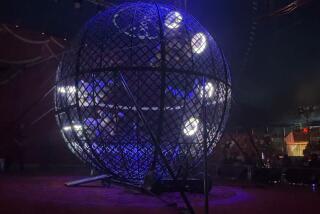Criss Angel, in a word: unbelievable
- Share via
Reporting from Las Vegas — If Criss Angel were blindfolded, straitjacketed, run over by a steamroller, locked in a steel box and dumped from a helicopter into the Pacific Ocean, he still might be easier to salvage from disaster than “Criss Angel: Believe,” the gloomy, gothic muddle of a show that officially lurched into being on Halloween night like some patched-together Frankenstein’s monster.
The multimillion-dollar production, which its backers hope will play at the Luxor casino until sometime around election day 2028, is nominally a collaboration by Angel, né Christopher Nicholas Sarantakos, the talented illusionist and star of A&E’s “Criss Angel Mindfreak,” and Cirque du Soleil, the Montreal-based franchisers of whimsical, breathtakingly acrobatic entertainments.
Yet “Believe” suggests less an artistic marriage made in accounting heaven than a shotgun wedding of clashing sensibilities in which the shotgun messily discharges en route to the altar. Indeed, the smeared blood and entrails are piled high and deep throughout “Believe,” the most death-obsessed show to emerge from Sin City since “CSI: Crime Scene Investigation.”
Keeping faith with the Las Vegas adage that nothing succeeds like overkill, the production opens with a video montage of Angel’s greatest hits, immolations, levitations, self-mutilations and assorted suicidal tendencies. (If you’re worried about spoilers or have a weak stomach, flip now to the comics page.)
Angel then materializes in torn jeans and a dark pullover, and warms up the audience with a bit of banter (“I feel your love!”) before he and co-writer/director Serge Denoncourt lay out the show’s central conceit. “Believe’s” framing device is that Angel accidentally receives a 6-million-volt jolt of electricity that fries off most of his face (a spectacle captured by an ever-present video camera). This propels him into deep hallucinatory space where our Siegfriedian hero must confront demons and angels that stalk his imagination.
These include a sinister troupe of dancing rabbits who, in one early sequence, tear Angel’s parboiled “corpse” apart and dance, exultantly hoisting his severed limbs and torso. In a later scenario Angel gets sliced in half with an electric blade, his oozing intestines visible through the smoky atmospherics.
Magic, like the circus, is an inherently dark and cruel art form, so there’s no harm in sprinkling a little S&M titillation around the edges of the production. After all, people come to Vegas for kinky thrills and the seductive whiff of make-believe danger.
The problem is that “Believe” doesn’t really have the courage of its most extreme convictions. So it swathes its fearless Grand Guignol fetishes in an awkward mishmash of themes, metaphors and visual stratagems. You name it, they try it here: rear-screen projections of dramatic cloud-swept skies, Middle Eastern dance music, “The Night on Bald Mountain,” giant poppies, whirling dervishes.
Cirque’s high technical standards are maintained by the designers, especially Ray Winkler (sets), Mérédith Caron (costumes) and Michael Curry (props and puppets), but to what end?
Then there are . . . those rabbits, some beautifully stylized, and others far scarier than anything encountered by Alice in Wonderland or Grace Slick. Whenever the manic pacing starts to flag, a posse of clowns in punk-Edwardian drag tumble on stage to mug, break-dance or shriek high-pitched gibberish.
There’s a sequence in which a straitjacketed Angel frees himself while spinning upside down above the audience and a couple of big, loud production numbers that play like excerpts from an aging heavy metal band’s reunion tour. But there’s little that expresses something interesting or unique about Angel as an artist, or a person. And while Cirque’s poetic imagery at its best can leave you rubbing your eyes and holding your breath, spectators here are more likely to find themselves stifling a yawn or wincing with embarrassment.
None of this would matter as much if Angel had a compelling live-stage presence. But “Believe” exposes him as a natural-born showman, which isn’t the same as a natural-born entertainer. He lacks comic timing and ad-libbing ability, falling flat with some very lame erectile dysfunction jokes. His personality simply disappears for long stretches of the show.
Some of his biggest applause of the night came for executing the simplest of tricks, like producing a bird out of hand. That’s a decent evening’s work for a backyard bar mitzvah or quinceanera magician, but it doesn’t quite justify a $100 ticket.
According to an Oct. 12 Times story, Angel previously tried to launch a show on Broadway and at other casinos before Cirque stepped in as creative partner and MGM Mirage Resorts (the Luxor’s parent company) stepped up with a reputed $100-million investment. Angel, for the record, retains top billing with “Believe” as “co-writer, illusions creator and designer, original concept creator and star.”
Cirque du Soleil, for all its past success, needs fresh inspiration. A few years ago the company began showing signs of having exhausted its very large sack of ideas. It started searching for collaborators, and came up with a great one, the Beatles, for the superb “Love” show, now playing up the Strip at the Mirage.
But the Fab Four offered Cirque’s conceptual wizards several instantly recognizable personalties to work with, plus, more important, a songbook of 200 tunes, many of them pop classics. Angel has no such large or spectacular body of work to psychoanalyze, dramatize and pump up to mythic proportions. He still may get there, but he hasn’t arrived.
Johnson is a Times staff writer.
More to Read
The biggest entertainment stories
Get our big stories about Hollywood, film, television, music, arts, culture and more right in your inbox as soon as they publish.
You may occasionally receive promotional content from the Los Angeles Times.











